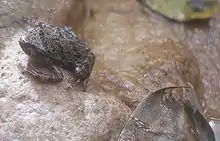Eastern ghost frog
The eastern ghost frog (Heleophryne orientalis) is a species of frogs in the family Heleophrynidae.
| Eastern ghost frog | |
|---|---|
 | |
| Scientific classification | |
| Kingdom: | Animalia |
| Phylum: | Chordata |
| Class: | Amphibia |
| Order: | Anura |
| Family: | Heleophrynidae |
| Genus: | Heleophryne |
| Species: | H. orientalis |
| Binomial name | |
| Heleophryne orientalis FitzSimons, 1946 | |
It is endemic to Western Cape Province, South Africa.[2] Its natural habitats are forest patches surrounded by mountain fynbos heathland. Adult frogs live near slow- to swift flowing perennial mountain streams in isolated canyons. They are typical sit-and-wait predators which hunt at night near to the splash zone of the mountain streams.[3] Breeding takes place in fast-flowing, perennial streams. Clutches of 120-190 eggs are layed extra aquatic under moss-covered rocks.[4] Their tadpoles take two years to complete their development[1] and possess unique larval features such as the appearance of both the admandibular and the adrostral cartilage.[5]
Eastern ghost frog is locally a common species that is not significantly threatened, but is locally impacted by introduced species.[1]
References
- IUCN SSC Amphibian Specialist Group (2013). "Heleophryne orientalis". The IUCN Red List of Threatened Species. IUCN. 2013: e.T55274A3026829. doi:10.2305/IUCN.UK.2013-2.RLTS.T55274A3026829.en.
- Frost, Darrel R. (2014). "Heleophryne orientalis FitzSimons, 1946". Amphibian Species of the World: an Online Reference. Version 6.0. American Museum of Natural History. Retrieved 15 March 2014.
- Vitt, L. J. (2008). "Herpetology". Herpetology 3rd Edition. San Diego: Academic Press/ Elsevier.
- Halliday, T. (2016). "The Book of frogs: A life sized guide to six hundred species from around the world". Brighton IVY Press.
- Lukas, Paul (2020). "Larval cranial anatomy of the Eastern Ghost Frog (Heleophryne orientalis)". Acta Zoologica. doi:10.1111/azo.12352.
